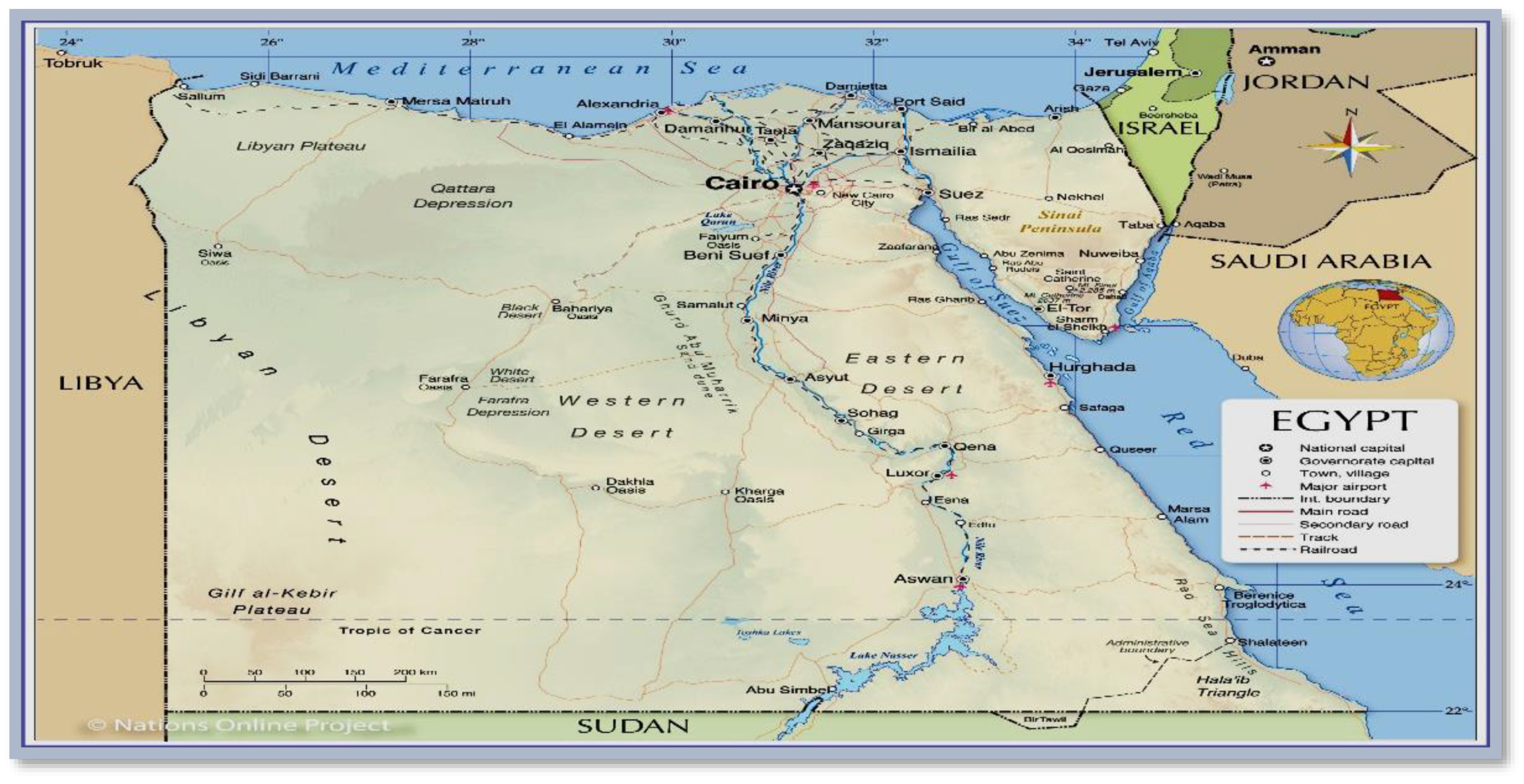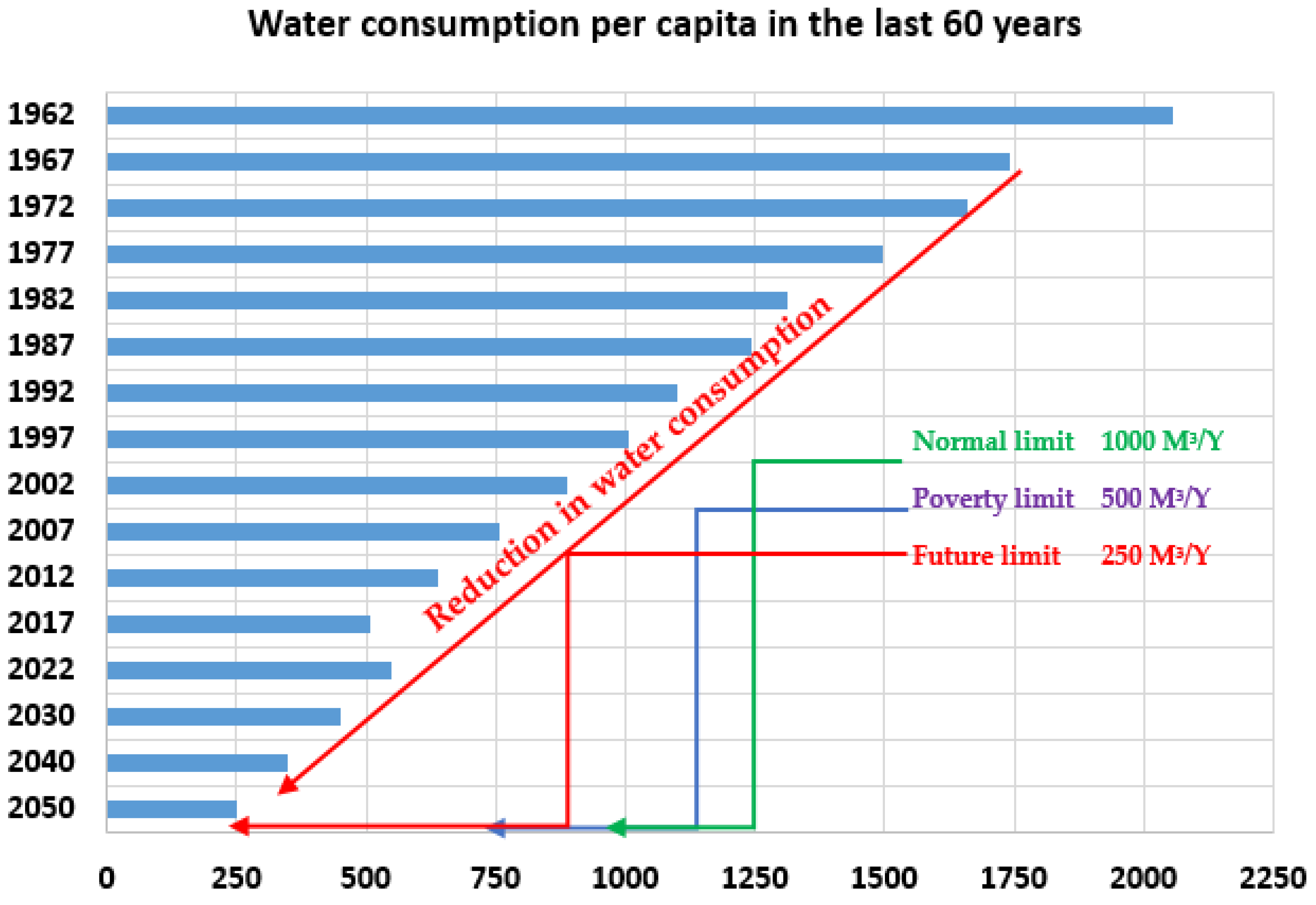Saving fresh water is a big challenge for the next generation due to enhanced living standards and population growth. In addition, the expansion of agricultural and industrial activities is causing unmatched demands for fresh water supplies across Egypt. The Nile River is Egypt’s main water resource, representing 69.4% of the total water resources, while rainwater, torrential water and groundwater, as well as recycled agricultural and sanitary drainage water and desalinated seawater, are estimated at about 30.6%. Smart drip irrigation systems are in great demand, especially in Upper Egypt. SDG’s of the circular economy and the WEF nexus lead to full implementation of drip irrigation systems, achieving ~6.6 BM3/year of direct saving from fresh water and/or doubling the cultivated area. In addition to PV tubes and other utilities, renewable energy, e.g, photovoltaic panels, will posses an important role in low-energy driven drip irrigation systems, reducing fossil-uses, CO2 emissions and devolving more sustainable processes that are less dependent on conventional energy sources.
1. General Introduction
Egypt attaches the utmost importance to the issue of water, in terms of preserving its water resources and good management, which has been translated into many comprehensive and specific legal agreements with the Nile Basin countries, which obligate everyone to respect them and not violate them
[1][2]. In return, Egypt cooperates with other Nile Basin countries and participates in many of its development projects
[3]. Egypt has also contributed to the establishment of many dams and underground drinking water stations, and has prepared the essential investigations for projects to build multi-aim dams, to provide drinking water and electricity to the African country’s citizens. Among the major agreements is the agreement of 1959
[4], according to which Egypt obtains 55.5 BM
3 of water annually, whereas Sudan gets 18.5 BM
3, and the total river revenue is 84 BM
3. Approximately 10 BM
3 of the river’s revenue is lost during the flow from south to north due to leakage and evaporation. In addition, the 2015 principles agreement declaration among Ethiopia, Sudan and Egypt, in Khartoum city, confirmed cooperation based on the understanding, benefit and gains for all under international law principles, and an understanding of the water requirements of downstream and upstream countries in their various aspects
[5]. Egypt’s water resources are estimated at about 81.39 BM
3 annually, most of which comes from the Nile River water, as well as very limited amounts of desalination, rainwater, deep groundwater and treated wastewater. In contrast, the total water needs in Egypt reach about 114 BM
3 annually (as per the Water Resources Ministry reports on 28 March 2021)
[6]. The gap is reimbursed by the surface groundwater and agricultural wastewater re-use in the valley and Delta, as well as the importing of food products from abroad corresponding to 32.61% of water annually as shown in
Figure 1 [7][8].
Figure 1. Water resources in Egypt.
2. Egyptian Water Policy & Strategy
Successive Egyptian governments have worked on preparing water strategies, policies, and national plans, which would contribute to achieving the maximum benefit from Egypt’s river water. At the beginning of 1998, the first integrated strategy for Egypt’s water policy was drawn up, based on its implementation on the theory of “integrated management of water resources”
[9], with the participation of various ministries and authorities. The cost of the strategy’s
[10] projects, with its various axes, amounted to £145 billion GBP. Egypt continued to implement it until 2017. The strategy is divided into three main axes: (a) maximizing the use of every drop of water, (b) eliminating pollution and confronting its problem and (c) cooperating with the countries of the Nile River Basin to preserve and develop it. The major strategy included two main axes: (1) the first axis is concerned with what the researchers might call the pursuit of good use of water resources, through the theory of integrated water-food resource management, which takes into account all the available and required resources to meet all uses and strike a balance between them through the adoption of a number of targeted policies that maximize the benefit of the water unit
[10]. (2) the second axis is to offer foreign alternatives, aimed at cooperating with the Nile Basin countries in order to develop their water resources and their proper exploitation, on the one hand, and the implementation of Upper Nile projects with the purpose of increasing river drainage and reducing losses for the basin countries benefit, on the other hand. At the end of 2020, Egypt launched a strategy for water resources management until 2050, within the axes of the National Water Resources Plan, at a cost of 50 B$, called “4T”, with the participation of a number of ministries
[11][12][13]. Among the most important projects that the ministry is currently implementing within the framework of this plan are the national project for rehabilitation and canals lining, as shown in
Figure 2; the project of transformation from flood irrigation (FI) systems to drip irrigation (DI) systems; programs for adaptation to climate changes; protection from sea level rise; and rain harvesting projects
[14][15][16][17][18][19][20]. This plan pays special attention to the middle years 2022 and 2030, for several reasons, including that Egypt has prepared a strategy of sustainable development goals (SDGs) for the country until 2030, with the aim of placing Egypt among the top 30 countries in the world, economically and socially, by 2030. In addition, the plan takes into account the objectives of the sustainable development strategy in Egypt
[18].
Figure 2. Project for rehabilitation and canals lining.
3. Water Resources and Usages
Water resources and footprint in Egypt, 2021 can be found in Table 1 and Table 2.
Table 1. Water resources in Egypt, 2021
[16][17][18][19].
Table 2. Water footprint in Egypt, 2021
[21].
4. Targeted Water Resources
There are several projects in Upper Nile with the aim of controlling its water loss and managing extra resources
[18][22][23][24], the most important of which are:
-
The “Jonglei Canal (JC) project” in South Sudan, which could provide ~ 4 BM3/year in its first stage and around 3 BM3/year in its second stage, to be divided evenly between South Sudan and Egypt.
-
The “Bahr al-Ghazal (BG) project”, which provides about 7 BM3/year, to be divided evenly between South Sudan and Egypt.
-
The “Mushar Swamps (MS) project”, which provides about 4 BM3/year of water.
-
Seawater desalination is one of the future prospecting for increasing water resources, especially since its cost is decreasing by using modern technologies. It is about 0.41 BM3/year in 2021.
-
Amending the existing cropping structure in line with the State’s water, productivity, export policy, and reducing the quantities of irrigation water for the cropped area, as the State’s plan aims to provide about 1.5 BM3/year by substituting beet cultivation for sugar cane and decreasing the cultivated rice area from 1.3 million acres to 0.95 million acres.
-
Reducing water losses; the Water Resources and Irrigation Ministry estimated water losses at approximately 35% of the total water discharge from the High Dam, or approximately 19.4 BM3, and it is likely that it is lost by evaporation and leakage, and the loss in channels of irrigation represents approximately 2.3 BM3/year.
-
Conservation of water resources by getting rid of weeds and aquatic plants resulting from their growth and saving about 0.75 BM3/year.
The researchers intend to move towards the use of the smart agricultural irrigation system technologies by producing advanced sensor devices at appropriate prices and quantities, to be accessible to farmers in order to measure the level of moisture in the soil with high accuracy, which achieves multiple benefits, the most important of which is the provision of irrigation water quantities, and increased productivity. Egypt announced on 7 May 2021 that about 35% have been transferred to the modern drip irrigation system, in addition to submitting requests to convert another 9.9% in 2022, at a cost of 18 billion GBP. On May 29 2021, the researchers began the integration of the water desalination strategy with the State’s general policy for rational water management, in addition to making maximum use of the water generated by all the various water plants, whether for treatment or desalination, as well as the localization of all components of water desalination technology in Egypt in an effort to possess the capacity in this field.
5. Per Capita Share of Water in Egypt for the Last 60 Years
The population increase in Egypt represents a major challenge to water resources, as the total population is expected to be more than 125 million persons in 2030, and approximately 175 million persons in 2050, putting pressure on water resources. In addition, changes in the climate, such as the noticeable rise in temperatures, as well as the sporadic and unprecedented climatic phenomena that Egypt is witnessing in the scarcity of rain, as well as the rising sea level and its dangerous negative repercussions on cities and coastal areas.
Figure 3 shows the water consumption per capita at the last 60 years; the sharp decline in water consumption versus population increase, from 1962 to now, is clear. The water resources are fixed, and with the growing population, the water crisis gap is becoming out of control; the future projections of water consumption reach 250 m
3/y. The Intergovernmental Panel on Climate Change (IPCC) predicts that midstream sea levels are to increase by up to 59 cm in the worst-case scenario that is expected to come in 2100
[21][22][23][24][25]. A rise of 0.5 m in the sea level would cause losses in land, tourism and facilities of more than $32.5 billion in Alexandria alone, and will cut off Alexandria from the Delta. Indeed, the process of erosion has increased in the Delta of Nile since the High Dam construction in Aswan during the nineteen-seventies, after many of the Nile sediments were confined. Moreover, significant losses of agricultural land are likely to occur because of soil salinization
[25][26][27][28][29][30]. Water-use data for agriculture in Egypt is inaccurate and often contradictory. The total area prepared for irrigation in 2002 reached 85% in the Nile Delta and Valley
[31]. The fresh water consumption amount in the agricultural sector in 2000 reached 86% of the total use. All wastewater in Upper Egypt flows back into irrigation canals and the Nile, which is estimated at 4.0km
3/year, and the amount of wastewater in the Delta of Nile region is estimated at ~14km
3/year. Approximately 10km
3/year of wastewater in the Delta region is pumped into fresh water streams, where it is transferred, after a while, into the sea
[32][33]. Wastewater re-use takes place in three ways:
Figure 3. Water consumption per capita in the last 60 years vs. population and future prospects for both.
-
Using public pumping stations, which pump water from sewers into irrigation canals. The amount used in this way is estimated at ~4.5 BM3/y in the Delta and 0.9 BM3/y in Fayoum and Upper Egypt.
-
In an informal way, by the farmers themselves when they suffer from canal water shortage. This is estimated at 2.8 BM3/y in the Delta alone.
-
Indirectly from drains in Upper Egypt, which drain into the Nile River, and this quantity is ~4 BM3/y.








